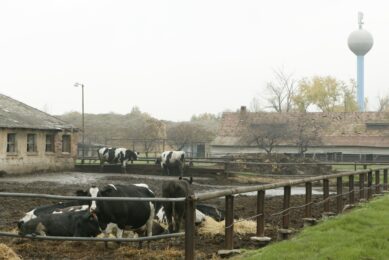‘ASF accelerated a lot in Vietnam’s pig industry’

African Swine Fever entered Vietnam 15 months ago. This aggravated a crisis that started in the pig industry in 2018. One thing is certain: ASF has accelerated developments in Vietnam’s pig industry. In a few years, the pig business will look completely different, according to Gabor Fluit, CEO Asia at animal nutrition company De Heus.
Gabor Fluit has been working for the Asian branch of animal nutrition company De Heus since 2008. Soon after, the company made its first steps into Vietnam. A well-timed choice, as De Heus and the country’s prosperity grew. The professionalisation of Vietnam’s pig industry allowed De Heus to acquire a strategic position on the Vietnamese feed market. The company is even participating on the market with 2 GP/GGP farms and a boar station, using Topigs Norsvin genetics.
African Swine Fever in Vietnam
African Swine Fever (ASF) entered Vietnam on February 1, 2019 in the northern province Hung Yen. The virus travelled at an astonishing speed and infected all of its 63 provinces by mid-August. This is a distance of 1,600 km in 6 months. In figures reported to the UN’s Food and Agriculture Organization (FAO), 6 million pigs have officially been a victim of either the virus or culling activities.
Given that the country had 29.1 million pigs (FAO) in 2016, roughly 21% of the pig population has disappeared. This number is much lower than general estimates for China (60% disappearance), yet at the same time substantially higher than official figures reported from China. However, the statistics only tell a small part of the story.
In addition to ASF, Covid-19 also hit Vietnam. In the sound fragment below, Gabor Fluit explains what the effects are of Covid-19 for the Vietnamese swine business.
How many pigs have disappeared due to ASF in Vietnam, according to your estimates?
“We cannot be sure. It is not clear how many pigs there were before it all started. And most certainly not everything has been reported. At a certain moment, there was no incentive for pig farmers to report an occurrence of ASF, like in many other countries in Asia. In the beginning, there were funds to compensate farmers, but those disappeared at some point.”
Let’s go back to when it all started, as ASF came on top of an earlier crisis. What happened?
“The year 2016 was a top year in terms of production. Vietnam had enormous amounts of live pigs, of which part were transported to China. A very profitable business. That all was a consequence of the years 2014-2015, when the Vietnamese authorities stimulated the purchase of animals. There are various estimates but some say that, however inefficient they might have been, there might have been 4 million sows in Vietnam at that time.
In the year 2017 the first setback followed, as China closed its borders. China realised that there were growing concerns in terms of food safety, and on Weibo, citizens complained about environmental problems and dead pigs on the roadside. From that moment on, only meat imports were allowed, by companies that had first slaughtered and processed the animals. That was the first big setback, and prices dropped heavily. Fast forward to mid-2018. Integrations continued despite low prices, Small backyard farms, however, were leaving the pig business. At that moment they had had their initial blows. It probably caused an initial hit on the total market of at least 10%.”
And then ASF still had to come.
“After 1.5 years of bad prices, the next huge setback followed: ASF. For many smaller farmers it was the final blow, and in some cases also larger farms had severe difficulties.”
2019 was a year full of uncertainties. Sales revenues, however, remained pretty stable, as we grew in both poultry and aquaculture markets
How did you notice at De Heus in Vietnam?
“In terms of feed revenue things were not that bad in 2018 and 2019. Even in the first 6 months of 2019, things went pretty well. Pig prices were very bad, so pig producers simply sold heavier pigs, with producers temporarily buying more feed in the first quarter of 2019. In the course of 2019, however, we noticed that the market was imploding. Many sow breeders and smaller pig farmers had to close shop.
In terms of feed, there were about 11.5 to 12 million tonnes of pig feed in the entire market in Vietnam in 2018. In 2019, that was perhaps 30% less than in 2018 and then the total ended up being around 8 to 8.5 million tonnes of pig feed. The really bad blow followed in the second half of the year. I think now, after ASF, less than 60% of the sow population remains compared to 2016. The remaining sows are relatively more productive, so the total number of pigs produced is down with a lower number. My estimation is that one third of the drop was caused by the 2017 China crisis and two thirds of the drop was caused by ASF. All in all, 2019 was a year full of uncertainties. Sales revenues, however, remained pretty stable, as we grew in both poultry and aquaculture markets.”
How did you help your customers to get through ASF?
“We showed them how to stay in business. Of course that involves very strict biosecurity, not allowing anybody to get on-farm, clean and disinfect well, change clothing regularly. And in case things do go wrong take action at that part of the farm as soon as possible. What we see is that many pig farms can still improve a lot in terms of biosecurity, there is still a lot of work to do.”
Did it have effects on consumption? Did people stop eating pork?
“In the first few months of the outbreak, yes, people ate less. There was more supply than demand because everyone was offering pork. That happened in other places, so in Vietnam as well. Then consumers embraced pig meat again. After all, Vietnam’s cuisine is heavily dependent on pork. Even when it became as expensive as Australian prime beef, there was continued demand.”
How has ASF changed the pig industry in Vietnam?
“ASF has accelerated at lot. Stricter demands have been pun into place, a larger demand for good pig genetics, more automation and fewer people that need to be on-farm. Many things that would happen eventually in the long term, have been modernised and implemented more rapidly.”
What has been the effect of the virus for the markets?
“Initially, the ASF outbreak was an enormous blow for pig prices, with demand and supply not in balance anymore. Those who have managed to keep the virus out will now be the ones to cash. In the long run, the situation in China will be restored. The Chinese are now constructing enormous complexes in the middle of nowhere, having used Russia as an example in the last decade, because Russia grew self-sufficient. In 2 to 4 years, the entire Asian pig market will be strong and will lean towards self-sufficiency. In the period inbetween, there will be a window of opportunity for exporters from the US, Brazil, the EU and Russia.”
What is De Heus Vietnam’s perspective for 2020?
“The feeling for 2020 is that we have not hit rock bottom yet. The situation in the first half of 2020 will be a lot less favourable compared to the first half of 2019. We think the entire Vietnamese market for pig feed will drop further compared to 2019. We expect that the pig feed demand will rise again in the second half of 2020 and especially in 2021. Pig prices can be very good, so eventually more feed will be needed. Pig farms will want to scale up again. It will depend on the availability of sufficient volumes of sows and piglets, yet GP/GGP farms have also been hit by ASF.”

Track the movement of African Swine Fever
For everything you need to know about ASF, from the latest outbreaks to controls stay up to-date…
Looking back so far, how have the Vientnamese authorities been tackling the situation?
“Looking at the bigger picture, I think the Vietnamese authorities have been on the right track by banning antibiotics as much as possible and by not granting building permissions just like that. Vietnam would like to professionalise the sector by stimulating the construction of better equipped farms. The role of backyard farms dwindles, in favour of larger farms. After Foot-and-Mouth Disease (FMD) and PRRS, smaller backyard farms kept coming back. That is absolutely different now.
The government had issued a new law: if you wish to keep animals for meat production, you will need to comply with strict environmental requirements, such as having proper wastewater treatment in place at the farm. That might be too much for people who would wish to keep several pigs in their backyard. If the government shows real motivation to enforce these rules, it will be beneficial for the sector and society in the long run.”
Is that situation in Vietnam different from other countries in Asia?
“No, this situation in terms of steps and development is reasonably similar to the situation in China. Of course, the development is different than in for example Cambodia or Myanmar. In these countries, development is at a different stage. In the West, many people idealise farm life: small-scale with a few chickens. In Asia, it is exactly the other way round. They do no longer desire the inefficiency and would like to improve their position.”
ASF will just be like FMD or PRRS, just one of those viruses we will have to learn to live with, until a vaccine has been developed
Do you expect a second wave of ASF outbreaks?
“We do take this risk into account. It is typically a virus that can be persistent and can come back in certain circumstances and can move in different ways.”
Has ASF created a new reality?”
“I am afraid we will not get rid of the virus again. It will just be like FMD or PRRS, just one of those viruses we will have to learn to live with, until a vaccine has been developed. And that it has been a phenomenon accelerating developments. This will be the start of super-strict biosecurity measures. We will have to accept that once in a while an infection will occur.”











